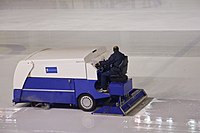
Photo from wikipedia
Abstract Estimating leaf wetness duration (LWD) is fundamentally important for crop disease monitoring and early warning. This study developed and evaluated a novel framework based on machine learning techniques with… Click to show full abstract
Abstract Estimating leaf wetness duration (LWD) is fundamentally important for crop disease monitoring and early warning. This study developed and evaluated a novel framework based on machine learning techniques with climate reanalysis data to estimate leaf wetness. We compared the Random Forest, kernelized Support Vector Machine, Feed-forward Neural Network, and Classification and Regression Tree models with hourly surface and near-surface meteorological inputs from state-of-the-art climate reanalysis datasets, ERA5 and MERRA2. The models were trained and cross-validated using three-year hourly leaf wetness observation data at nine agricultural sites in Alabama and six sites in California. The models were intercompared with each other and with a simple model based on observed relative humidity (with 90% used as threshold, referred as RH). The results indicated that the machine learning models based on ERA5 showed better performance than the MERRA2-based models as well as the observation-based RH model. In particular, the ERA5-based Random Forest model showed the best performance for estimating hourly leaf wetness occurrence (Accuracy = 83%, Precision = 78.2%) and daily LWD (MAE =2.8 h, RMSE = 4 h) than the other approaches. In comparison with the RH method, the ERA5-driven Random Forest model showed at least 2 h smaller MAE and RMSE than the other methods for estimating daily LWD, suggesting a great potential for practical applications. The results also showed that the ERA5-driven Random Forest model accurately predicted the leaf wetness occurrence in space (with 70 to 87% accuracy), suggesting a potential for large-scale crop disease surveillance and climate impact assessment, particularly for regions with sparse in situ observation data.
Journal Title: Agricultural and Forest Meteorology
Year Published: 2021
Link to full text (if available)
Share on Social Media: Sign Up to like & get
recommendations!